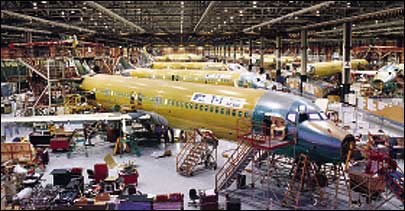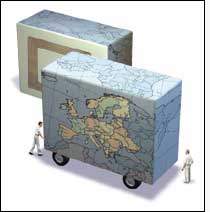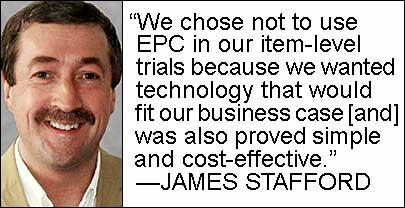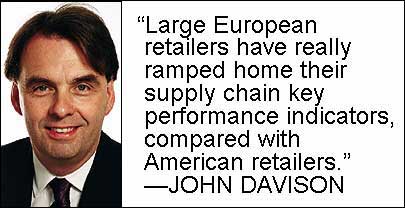Oct 01, 2005In early 2001, Wal-Mart joined a fledgling research effort at the Massachusetts Institute of Technology to support the development of the Electronic Product Code, a low-cost radio frequency identification system designed to track goods globally. Across the Atlantic, Marks & Spencer, one of the largest retailers in the United Kingdom, was examining the possibility of putting RFID tags on reusable trays in its supply chain. Both companies began field trials a year later, and today, both are rolling out RFID technology in stores and distribution centers. But the two retailers are taking vastly different approaches.
Wal-Mart, of course, required its top 100 suppliers to put UHF EPC tags on pallets and cases beginning in January 2005, and it has set an ambitious goal of having all suppliers ship tagged pallets and cases by the end of next year. The retailer has deployed interrogators in three distribution centers and more than 125 stores so far, to better manage inventory and reduce out-of-stocks.
Marks & Spencer, by contrast, has eschewed UHF EPC technology and the tagging of pallets and cases in the supply chain. Instead, it put 13.56 MHz tags on more than 3 million reusable trays to improve productivity in its grocery supply chain. It's also using proprietary UHF technology to tag individual clothing items, to improve on-shelf product availability.
While these two retailers have similar goals, their divergent paths reflect deep differences in the way RFID—in particular, UHF EPC technology—is being harnessed in the supply chain on two different continents. Retailers are driving adoption in Europe, as they are in the United States, but until recently, restrictions on UHF interrogators in Europe kept them from moving aggressively to adopt EPC. Also, the nature of European retailing has led companies to focus less on tracking pallets and cases and more on returnable transport items (RTIs), such as shipping trays, to improve visibility. And they are moving to item-level tagging in specific categories of high-value goods to achieve greater efficiencies.
Others industries, including aerospace, defense and pharmaceuticals, are also moving to adopt EPC (see "RFID Spreads Its Wings in Europe" subhead). As a result, the market for RFID technology in Western Europe (defined as the European Union plus Switzerland) will grow to $1.9 billion in 2008, from $164 million last year, according to a study by Juniper Research.
Technical Hurdles
When EPC technology was in the early days of development at the Auto-ID Center at MIT, Europe was already ahead of the rest of the world in using 13.56 MHz RFID in closed-loop systems, such as tracking reusable assets and uniforms in industrial laundries. Most European retailers and manufacturers had little enthusiasm for the concept of tracking goods in the open supply chain with UHF tags, because European regulations limited the use of the technology in their countries. UHF interrogators were restricted to half a watt of effective radiated power (ERP), which meant UHF tags could be read from no more than about a meter away (3 feet). That wasn't good enough to read tags on cases moving through a 3-meter-wide dock door. In the United States, interrogators could use 4 watts of effective isotropic radiated power (a slightly different measure), and tags could be read at 10 to 12 feet (3 to 4 meters).
Another issue for European companies has been the lack of an EPC protocol that works well in Europe. The first-generation EPC tags were developed in the United States and were optimized to perform well in the 902 MHz to 928 MHz band used in the United States. The tags didn't work as well at 869.4 MHz to 869.65 MHz, the UHF band used in Europe.
In September 2004, the European Telecommunications Standards Institute (ETSI), which oversees radio spectrum standards in the European Union, raised the power limit of UHF systems to 2 watts ERP and increased the bandwidth these systems could use to 865 MHz to 868 MHz, which should greatly improve performance. And systems based on the second-generation EPC standard, which was designed to work from 860 MHz to 960 MHz, are expected to perform well in Europe.
The Metro Group in Germany and Tesco in the United Kingdom are adopting EPC technology and promoting it as a way to track goods in the European supply chain. Tesco plans to begin receiving tagged pallets and cases from one supplier by the end of this year. Metro has already deployed EPC portal interrogators in several distribution centers and stores and is accepting tagged pallets from more than 10 of its largest suppliers. Kimberly-Clark, for example, is tagging about 200 pallets a week for shipment to a selection of Metro stores.
But it's too early to say whether they and other European retailers, as well as manufacturers, will benefit from using EPC Gen 2 technology to tag pallets and cases moving through the supply chain. "Our drive for anything we do using RFID is finding out the business case for us," says Geoff Mortley, process development manager at Kimberly-Clark Europe. "The only way we can do that is by working with retailers to try and identify it, but we told Metro we reserve the right to delay moving to case-level tagging until we find the business case."
Kraft Foods has also been tagging pallets and cases shipped to Metro. "So far it's been difficult to judge the potential ROI [from UHF EPC] because we have been using relatively unsophisticated tags of variable quality and very labor-intensive processes to apply them," says Peter Jordan, director for international B2B strategy for Kraft Foods. "We have regarded this as an R&D exercise to find out how the technology works."
Not all retailers in Europe are embracing UHF EPC systems. Marks & Spencer considered using it for its apparel item-tagging trials, and instead opted for its own RFID system. But M&S is in a unique position: It has almost complete control over its garment supply chain because the company sells only its own brand products delivered exclusively by its suppliers. "We chose not to use EPC in our item-level trials because we wanted to use technology that would not only fit our business case but was also proved, simple and cost-effective," says James Stafford, head of clothing RFID for Marks & Spencer.
Different Business Practices
Large U.S. retailers have big stores with plenty of storage space in their back rooms and on shelves. And they typically have massive distribution centers that serve many stores in a large geographical region. So the focus is on moving large numbers of cases over long distances efficiently. Wal-Mart, for instance, doesn't use any pallets or RTIs in its trucks. Cases are stacked floor to ceiling. When these cases are unloaded at the store, their bar codes are not scanned to update inventory because it would take too much time and cost too much in labor. With RFID tagged cases, the retailer can automate the collection of information on what's arriving at the store.
European supply chains are far different. Even though the European Union has created a single market across 25 countries, the major retailers largely remain national players—and they have smaller and more centralized supply chains than their counterparts in the United States.
And space in retail stores is usually more limited. Where a large U.S. retailer can devote 25 percent of its area in a superstore to inventory, its European counterpart has a fraction of that to use. "We don't have the luxury of operating large back-room warehouses at store sites, and the cost of labor is more expensive," says Marlow Truman, RFID expert in professional services firm Deloitte Touche Tohmatsu. "Having more stock means either a less efficient operation or a more repetitive operation, and it's something that we are not able to support in Europe."
European retailers often pick items in a distribution center and place them in a tote or tray that has a bar code with a unique number. The totes are then put on a dolly or in a roll cage and loaded on a truck. When a delivery is made to a store, the driver needs to scan the bar codes on the totes or trays to confirm what inventory has been delivered to the store. European retailers that use this system have greater visibility today into their supply chain than their U.S. counterparts.
"Large European retailers have really ramped home their supply chain key performance indicators [KPIs], compared with American retailers," says John Davison, research director for retail at Gartner. "That means the Americans have more to gain from RFID at pallet and case level, because the bottom line is, the less impressive your KPIs, the more likely you are able to get some quick wins from implementing pallet and case RFID."
Bar code tracking systems are not perfect. Bar codes sometimes fall off or get damaged, and people occasionally forget to scan them. RFID can reduce errors and speed up the process of data collection. Marks & Spencer, for instance, estimates that when it switched from using bar codes to RFID tags, it reduced the amount of time required to read stacked trays of food by more than 80 percent.
Tesco is also using RFID to track its RTIs. Back in 2003, the retailer began attaching EPC tags to its shipping trays and dollies at its national distribution center in Milton Keynes, England. The trays are loaded with high-value, high-shrink items, including perfume and aftershave, beauty products, packs of disposable razor blades, pharmaceuticals, batteries, electric toothbrushes, cameras, phones and computer accessories. They are then shipped to regional DCs and on to stores.
The company found that tagging RTIs reduces out-of-stocks by improving supply chain visibility, increasing inventory accuracy and reducing shrink. Tesco is now deploying RFID interrogators at 1,400 stores and 30 trunk (regional) distribution centers and expects to complete the job by the middle of next year.
The downside of tagging RTIs is that retailers lose visibility of the inventory once the items are taken out of the RTI at the store. But visibility in stores is not as big an issue in Europe as it is in the United States, where misplaced stock in the back room is a key contributor to out-of-stocks. Since European retailers have smaller back rooms, they have less stock, which makes it easier to track.
Retailers provide the tagged RTIs to their suppliers. But suppliers still have to invest in interrogators and software in order to read tags and pass data about shipments to the retailer. In 2003, when Marks & Spencer told Worldwide Fruit that it would have to ship fresh fruit in trays with RFID tags, the U.K. produce supplier expected to see no benefits, since it was already shipping its deliveries with an accuracy of 99.5 percent. "When Marks & Spencer told us we would have to use RFID, we saw no return on investment at all, only cost," says Dave West, operations manager at Worldwide Fruit.
But by integrating reads from two portals deployed at its packing and distribution center and linking information from those reads to its existing warehouse management and shipping dispatch systems, the company realized a return on its investment within four months. The savings came from reducing the nearly £160,000 (US$297,000) a year that Worldwide Fruit was being charged for that 0.5 percent of incorrect shipments to Marks & Spencer. Using RFID has pushed accuracy to 100 percent. "We looked at having to use RFID," says West, "and realized that we could improve our own business efficiency."
Beyond Pallets and Cases
Tracking RTIs is the proverbial low-hanging fruit in Europe. It delivers visibility and improved on-shelf availability by making sure the right goods get to the right stores. And the cost of the EPC tag is amortized over the life of the RTI.
Given that the ROI from tagging pallets and cases has not been proved, analysts say that European retailers will move more quickly toward item-level tagging than their counterparts in the United States. And many believe that RFID—EPC in particular—can deliver the most value at the item level because it can improve on-shelf availability and perhaps reduce shrinkage.
"Europe is probably ahead in terms of use and thinking about RFID," says Gartner's Davison. "U.S. retailers have espoused very little interest in item-level RFID. It's Europe that needs to crack the item-level problem."
U.S. retailers did brief trials of smart shelves that track at the item level and then abandoned them. They are focused on using EPC tags to track cases of all products, from high-value DVD players to low-value cases of shampoo. This is a challenge for many manufacturers that have to do the tagging, because much of the margin on a case of shampoo can be eaten up by the cost of a $1 smart label.
European retailers have carried out extensive item-level trials, but they have focused on high-value categories because it doesn't make economic sense to tag low-value items. And manufacturers are less likely to object to paying for the tag if it is a high-value high-shrink item.
Metro is tracking three products at the item level: Gillette razor blades, Kraft's Philadelphia cream cheese tubs and Procter & Gamble's Pantene shampoo. Marks & Spencer is using UHF tags on men's suits at nine stores and plans to roll out the technology to 59 of its approximately 400 stores in the spring of 2006. "For us, RFID is about making improvements in the stores. Our aim is 100 percent availability," says Marks & Spencer's Stafford.
Tesco has been using 13.56 MHz passive RFID tags to track DVDs at two stores for more than a year. The retailer wants to switch to UHF EPC tags and expand the trial to eight additional stores. It plans to use the system to make sure DVDs are replenished regularly and any out-of-place discs are returned to the right location. At some stores, it will use UHF EPC tags to track DVDs, but it will not change its processes to replenish more frequently. That way, Tesco can determine how much sales will increase using RFID to improve on-shelf availability.
The European approach helps manufacturers looking to develop their own potential ROI from RFID deployment. "Category implementation is better for most manufacturers, because it means starting to get critical mass in your own production areas," says Kraft's Jordan.
With the potential ROI from item-level tagging—and the lifting of some of the technical limitations with the introduction of EPCglobal Gen 2 equipment tuned to the European spectrum—analysts expect European companies to leapfrog their U.S. counterparts in using EPC technology.
"European retailers have squeezed more cost out of the rest of the supply chain [than U.S. retailers], but if there's still a problem, it's in the store, and one of the big problems is product availability," says Davison. "Impacting product availability is difficult to do without item-level RFID tagging. From tracking reusable assets, it's only a small step to tracking the individual products carried in the assets—and that's when RFID becomes transformational."
RFID Spreads Its Wings in Europe
RFID is spreading beyond the retail and consumer packaged goods supply chain in Europe. Airbus has teamed with its U.S. rival, Boeing, to develop standards for using RFID within the airplane manufacturing industry. Jens Heitmann, senior manager for system/equipment standardization, process and methods at Airbus, says his company is looking to use Electronic Product Codes to track individual airplane parts and better serve its airline customers.
Today, he says, when an airline needs to service an Airbus plane, the company communicates with Airbus using electronic data interchange or another point-to-point system. Airbus would like to create a Web-based system that uses EPCs to manage parts, allowing all airlines to use a similar system. This would reduce the airlines' costs and enable Airbus to better serve their needs by combining better part tracking and histories with a less-expensive, standards-based communication system.
In other sectors, Europe lacks the super-adopters that are driving RFID adoption in the United States. No ministry of defense in Europe is requiring suppliers to put passive tags on pallets, cases and individual items, as the U.S. Department of Defense has done. But Europe is moving toward adopting RFID in the military supply chains. The ministries of defense in Britain and Denmark have signed contracts to use the same active (battery) RFID tags from Savi Technology that the DOD uses. And members of the North Atlantic Treaty Organization (NATO) have been tracking goods with RFID as they travel through seven European countries to Afghanistan.
More recently, members of NATO agreed to use RFID standards established by the International Organization for Standardization (ISO) to track shipments and assets, which paves the way for adoption by guaranteeing that shipments tagged by one NATO military unit can be read by those from another country. (EPCglobal's Gen 2 standard has been submitted to ISO for approval and will likely become the de facto UHF standard globally.)
Another difference between North America and Europe is that European government agencies have not pushed RFID as a solution to some problems. For instance, after an outbreak of mad cow disease, Canada mandated the use of RFID to track all cows. The United States is also moving (slowly) in that direction, but most European governments have not take that step. And while the U.S. Food and Drug Administration hasn't mandated the use of RFID, in a February 2004 report it strongly recommended the use of the technology to help combat counterfeiting of drugs. That led most U.S. drug makers to launch pilots.
European pharmaceutical companies are slightly behind their U.S. counterparts, but they have begun to examine the potential of RFID. For example, GlaxoSmithKline (GSK), based in Middlesex, England, will begin testing RFID on a number of drugs within the next year. And before the end of the year, the GS1 European Healthcare Initiative will launch a pilot that will use EPC technology to track brand name and generic drugs at the pallet, case and item levels.
RFID and Privacy: No Room for Secrets
The experiences of Marks & Spencer and the Metro Group—two major European retailers that have run trials of RFID at the item level—illustrate how companies should deploy RFID in stores if they want to win the trust of their customers. Privacy concerns in Europe, as in the United States, center on how data collected at the item level might be linked to personal data and used to develop a profile of a person's actions and purchases.
In the spring, M&S will start tagging all garments in six departments across 59 of its U.K. stores. This is the third stage in an RFID pilot that started with tagging men's suits, shirts and ties in one store in 2003 and currently includes nine U.K. stores. Its expansion reflects the benefits the company is realizing in improved in-store availability and inventory management—and the acceptance by its customers of item-level tagging.

Before the initial pilot began, M&S consulted with several national and international privacy groups to ensure its trial incorporated their concerns. To protect customers' privacy, the RFID tags were designed to be cut off or thrown away with the packaging, and M&S did not record which customers purchased which items of apparel. Shoppers also received an informational brochure about the tags and their use.
"M&S was sensitive to the privacy issue and addressed it early on," says Chris McDermott, founder and director of NoTags.co.uk. "However, concern remains that in a wider deployment, those precautions may get swept away."
Metro also instituted an RFID consumer privacy policy and went to great lengths to publicize its use of RFID tagged pallets and cases in its Extra Future Store in Rheinberg, Germany. But in February 2004, the company failed to disclose that it had included RFID tags in some 10,000 Extra Future Card customer loyalty cards at the Future Store. The tags contained customers' unique ID numbers, apparently violating Metro's own consumer privacy policy of not linking RFID with personal data. Metro recalled the RFID loyalty cards when privacy groups discovered the pilot. But the damage was done. The incident was widely covered in the international press, highlighting the concerns people have about item-level RFID tagging.
Since then, Metro has become one of 15 companies in Germany—including Volkswagen, SAP and Gillette—along with GS1 Germany, the local EPCglobal organization, to sponsor the Information Forum RFID, designed to educate businesses and consumers about the technology. "There needs to be information about RFID in the market—about what it can and what it can't do, and not just from Metro," says Albrecht von Truchsess, a spokesperson at Metro.
While consumers are wary about item-level tagging, a 2003 Gartner survey of 1,000 shoppers in the United Kingdom revealed that their privacy concerns could be offset by benefits, such as faster checkouts, better in-stock positions, easier returns and better information. It seems European retailers and manufacturers aren't the only ones looking for a return on investment before jumping on board with RFID.



